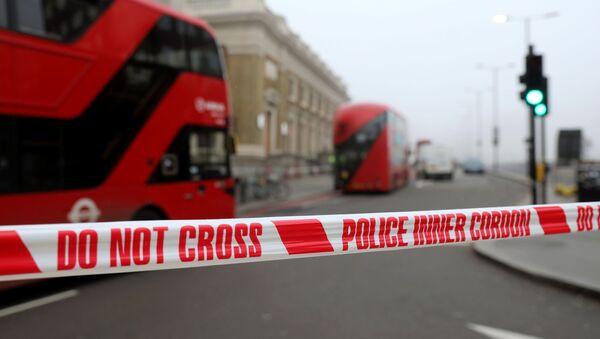A man who carried out a knife attack on London Bridge on Friday, killing two people and injuring several more, has been identified as 28-year-old Usman Khan, a convicted terrorist who was released last December on licence. The revelation about the convicted terrorist’s identity and his automatic release has unsurprisingly led to a public outcry.
How Many Years Did Attacker Spend in Prison?
Khan was involved with an al-Qaeda*-inspired group that was plotting to bomb the London Stock Exchange in 2010, as well as other administrative facilities in Britain. The group also planned to establish a terrorist training camp in Pakistan-administered Kashmir on land owned by Khan’s family, aiming to depart the UK in January 2011.
Khan, however, was captured shortly afterward and initially sentenced to an indeterminate time in jail, with the judge warning about his “serious” threat to society. The sentence was later struck down in the Court Appeal in April 2013, and he was then given a 16-year sentence.
“There is an argument for concluding that anyone convicted of such an offence should be incentivised to demonstrate that he can safely be released; such a decision is then better left to the Parole Board for consideration proximate in time to the date when release becomes possible”, Lord Justice Leveson reportedly said in 2013 with regard to Khan’s criminal case, as quoted by the Daily Mail.
The media reported that despite the Parole Board having to decide when Khan was safe to be released from jail, the panel itself confirmed in a statement that it had “no involvement” with the release of the identified attacker, meaning that he was released from prison “automatically on licence”, as required by law.
Parole Board statement on London Bridge attack on Friday 29 November 2019. https://t.co/BXpVtcoal8 pic.twitter.com/gNV5ACi6cd
— The Parole Board (@Parole_Board) November 30, 2019
The Metropolitan Police confirmed on Friday that the terrorist was released from prison in December 2018 on an electronic tag, after serving only seven years.
“This individual was known to authorities, having been convicted in 2012 for terrorism offences”, Metropolitan Police assistant commissioner Neil Basu said in a statement. “He was released from prison in December 2018 on licence and clearly, a key line of enquiry now is to establish how he came to carry out this attack”.
Automatic Release? ‘It’s Crazy’
The revelations about Khan’s automatic release unsurprisingly caused a stream of comments trying to put the blame squarely on the judicial system’s shoulders, while also denouncing the practice of early release of such criminals.
Yet another law that needs to be changed. @BorisJohnson
— News From The Echo Chamber (@FRemainer) November 30, 2019
So, it's all down to Lord Brian Leveson. I hope he is required to attend the inquests and face the families of the two people murdered as a result of his decision to change the sentence of Usman Khan.
— Maren Bennette (@marenbennette) November 30, 2019
It's crazy that dangerous people are released early, yet anyone selling weed rots in jail. It's crazy
— Litha Riddle #VoteLabour 😈 (@LithaR) November 30, 2019
Scary but you do regularly release people far too early when they've not been sufficiently punished and when there's insufficient evidence of rehabilitation. Hopefully this will be a wake up call to you too.
— Patriotic ally (@patriotic_ally) November 30, 2019
Why was Usman Khan a former prisoner convicted of terrorism offences was allowed to be released from prison out on licence who ever made this decision it was the wrong decision.
— Vanessa field (@Vanessafield16) November 30, 2019
Johnson Condemns Terrorists Early Release
Speaking before the government's emergency committee Cobra on Friday, UK Prime Minister Boris Johnson condemned the practice of automatic release of convicted terrorists, saying that it was “mistake to allow serious and violent criminals to come out of prison early”.
“It is very important that we get out of that habit and that we enforce the appropriate sentences for dangerous criminals, especially for terrorists, that I think the public will want to see”, the UK prime minister added.
Johnson also said that police would take extra measures in patrolling the streets in the coming days “for reassurance purposes”.
What Happened on London Bridge?
Police said the attack began at Fishmongers' Hall on London Bridge, where Khan had been attending a Cambridge University conference called “Learning Together Five Year Celebration Alumni Event” aimed at helping former prisoners to reintegrate into society. Khan, who started stabbing fellow delegates with knives while clad in a fake suicide vest, was allegedly wearing a monitoring tag during the conference, because his movements were still restricted. But the convicted terrorist was given permission to attend the event anyway.
A former British senior intelligence and security officer Philip Ingram said that despite Khan being under authorities’ supervision since his release, something had “not worked” in his risk assessment.
“Clearly something has not worked in the risk assessment of this prisoner released back to society under licence and those processes will have to be reviewed urgently, especially for those convicted of terror offences”, Ingram said.
The former British officer added that you cannot monitor every former convict on a 24-hour basis, noting that it does not take a long time to commit this kind of attack.
“If he had shown any inclination of planning something as this then it would have been flagged however, it only takes seconds to grab 2 kitchen knives and you can make a fake bomb vest in a few minutes”, Ingram concluded.
In June 2017, another terrorist attack was carried out on London Bridge, after a van was deliberately driven into pedestrians, before crashing on the south bank of the River Thames. Another stabbing incident later occurred in nearby Borough Market.




